Honor Award
Homegrown: A Residential Guide to Edibility
Vanessa Gilbert, Student ASLA, Ball State University
Faculty Advisor: Meg Calkins, ASLA
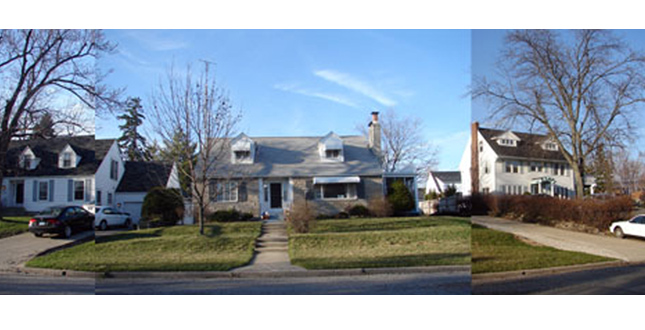 Close Me!
Close Me!Existing Front view of 1006 Wayne Street Muncie, Indiana
Download Hi-Res ImagePhoto: Vanessa Gilbert
Photo 1 of 12
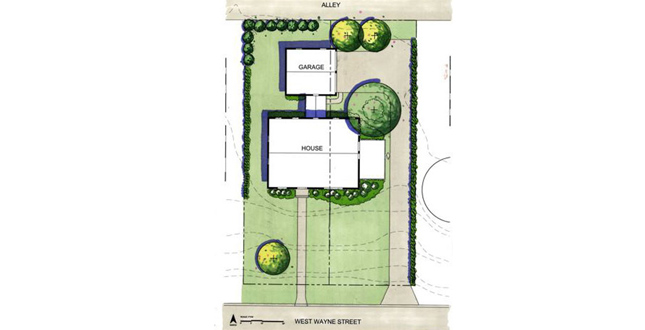
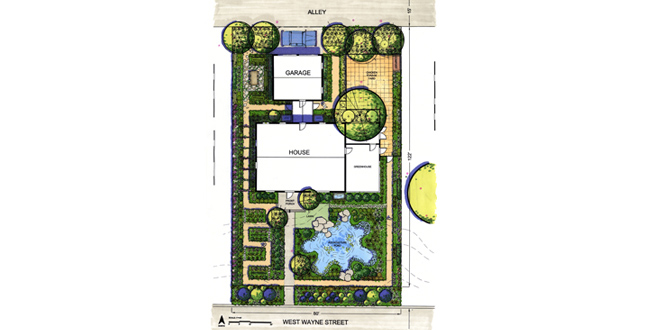
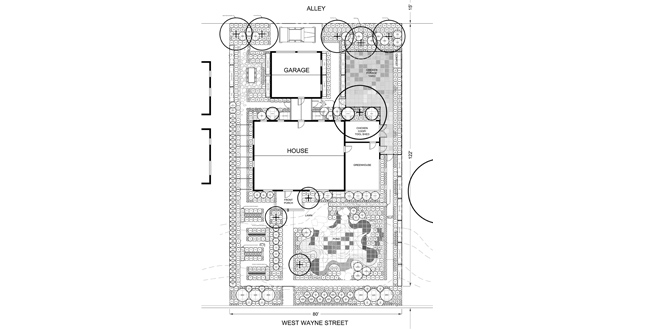 Close Me!
Close Me!Redesigned Planting Plan for 1006 Wayne Street
Download Hi-Res ImagePhoto: Vanessa Gilbert
Photo 4 of 12
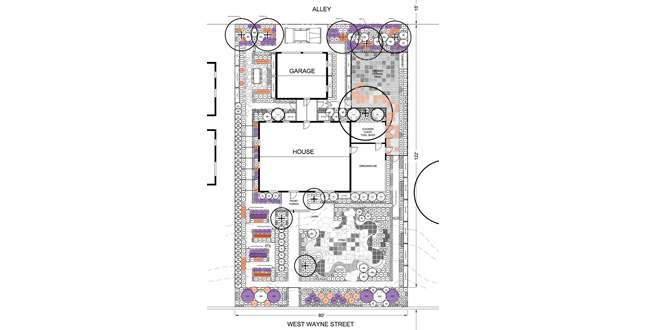 Close Me!
Close Me!Nitrogen Usage. This diagram shows how nitrogen fixers (orange) and heavy nitrogen users (purple) were planted together to create balance.
Download Hi-Res ImagePhoto: Vanessa Gilbert
Photo 5 of 12
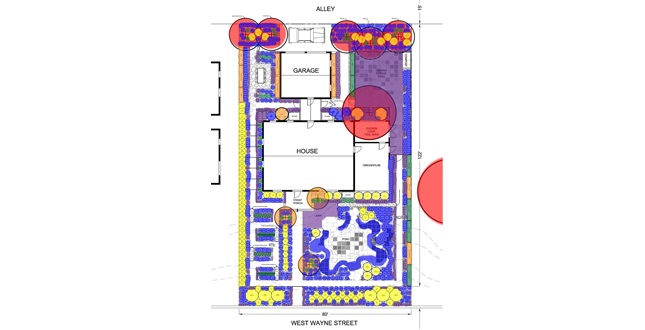 Close Me!
Close Me!Layer Usage. The design of 1006 Wayne Street utilized the seven layers of a forest. Each layer is represented in the diagram as a different color. Red: Canopy Layer, orange: lower canopy and bamboo layer, yellow: shrub layer, green: vine layer, blue: herbaceous layer, and purple: groundcover layer.
Download Hi-Res ImagePhoto: Vanessa Gilbert
Photo 6 of 12
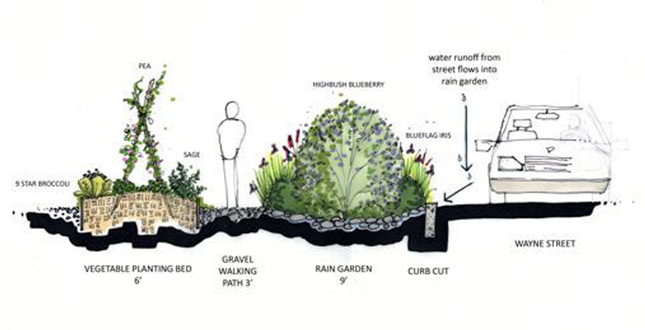 Close Me!
Close Me!Rain Garden. The above drawing is a section cut through the rain garden that runs along the south property line. The curb is cut allowing water from the street to flow into the garden and filter through the aggregate.
Download Hi-Res ImagePhoto: Vanessa Gilbert
Photo 7 of 12
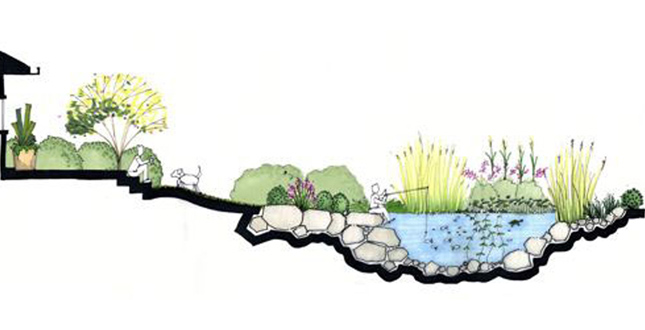 Close Me!
Close Me!Aquaculture Pond. Section cut through the aquaculture pond from north to south. It shows the connection of the lawn and front porch to the water’s edge and also the interaction between humans and environment.
Download Hi-Res ImagePhoto: Vanessa Gilbert
Photo 8 of 12
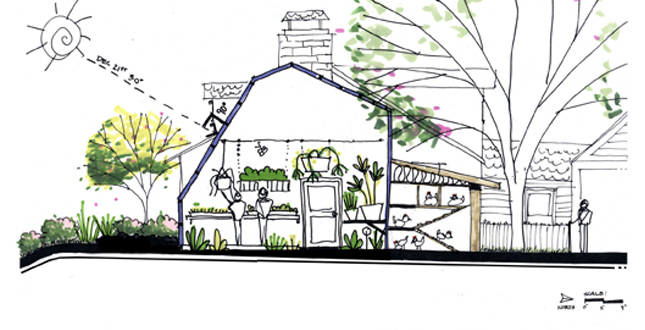 Close Me!
Close Me!Greenhouse and Chicken Coop. Sketch that illustrates the combination of the chicken coop and greenhouse and how they are connected to share heat. The body heat from the chickens help regulate temperatures in the greenhouse during winter months.
Download Hi-Res ImagePhoto: Vanessa Gilbert
Photo 9 of 12
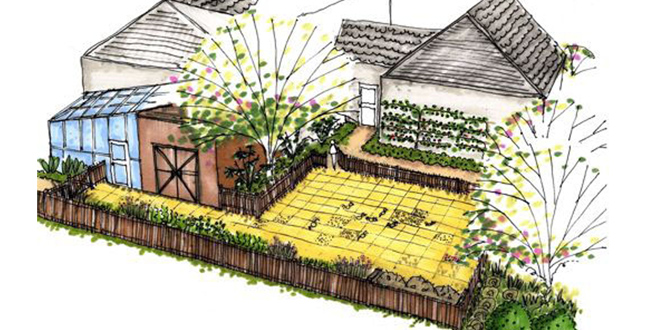 Close Me!
Close Me!Chicken Forage Yard. A fenced forage yard is situated around the chicken coop so that the chickens have direct access and are able to roam free without hindering planting beds.
Download Hi-Res ImagePhoto: Vanessa Gilbert
Photo 10 of 12
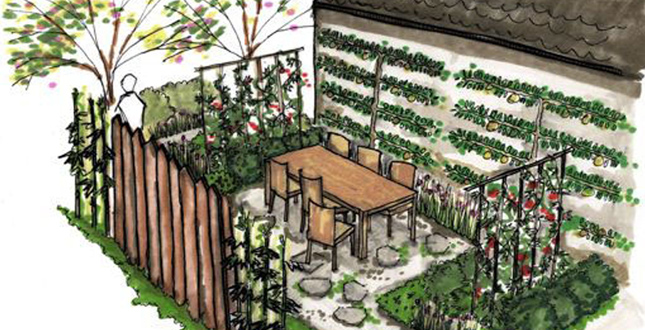 Close Me!
Close Me!Outdoor Eating Area. This view is looking east into the outdoor eating area. The space is screened by espalier fruit trees, bamboo, and tomato trellises.
Download Hi-Res ImagePhoto: Vanessa Gilbert
Photo 11 of 12
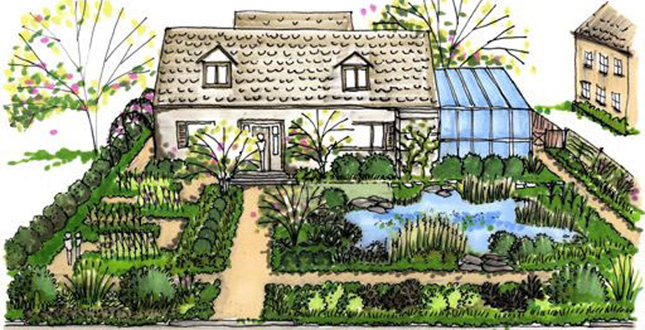 Close Me!
Close Me!Front Yard View of Final Redesign. This is a sketch of the front of 1006 Wayne Street after its redesign. The aquaculture pond is on the right, in front of the greenhouse and the switchback beds are on the left.
Download Hi-Res ImagePhoto: Vanessa Gilbert
Photo 12 of 12
Project Statement
This project examines the potential for urban residences to become self-sustaining and productive environments using a ¼ acre lot in Muncie, Indiana as an example. It explores how society has grown further from nature, creating a gap that has resulted in the underutilization of the environment. This project reconnects humans to nature while creating more sustainable environments to live in, benefiting nature as well as the health, wealth, and happiness of people and their communities.
Project Narrative
The site for this project is a two-story residence located at 1006 Wayne Street in Muncie, Indiana. It is two blocks away from Ball State University and is situated in a neighborhood comprised mostly of college students and middle class residents. The home is approximately 2,385 square feet sitting on a quarter acre lot. It has a concrete driveway, a small grass lawn in the front approximately 5,000 square feet in size, a large sugar maple to the southeast, and a pear to the west. It is privately owned.
This site was chosen because it represents a typical home found in the mid-west. It is neither large nor small and has limited space, making it an ideal example of how ample lawn space is not a prerequisite to a successful, self-sustaining, ecologically balanced home. The original house structure was kept and the principles of permaculture, forest gardening, and paradise gardening were used to transform the residence from a monoculture of grass into a balanced ecosystem that provides food and beauty for its residents. Design and ecological thought were used to choose plants suitable for the intent and location. As a result, a small-underutilized space was turned into a rich fruitful paradise.
Design Principles
In order to produce half of the food needed to feed an average family of four, certain measures have to be taken. Plants have to be placed in their proper locations, have the nutrients that they need, and space must be wisely used. The following are the three main planting design principles used to make this site as productive and balanced as possible.
Companion Planting
Companion planting is grouping plants together and taking advantage of their natural needs and functions to benefit one another. One companioning that was focused on heavily in this design was nitrogen fixers and nitrogen takers. This was done because low nitrogen levels are one of the main reasons people use inorganic fertilizers. But if people understood plant interactions they would realize that there are certain plants that produce nitrogen and if these plants are paired with plants that need a lot of nitrogen than they balance each other out and inorganic fertilizers become obsolete.
Alternative Plants
Alternative plants are edible plants that are native to the area but aren’t usually commercially cultivated. They bring opportunities for more successful crops because they are in their natural habitats. They also provide diverse food choices that can be used as substitutions for more common foods.
Vertical Space
Utilizing vertical space is key for a site to reach its maximum productivity. It increases yields by increasing growing area without taking up bed space. Nature does this with vines and trees. Vines grow up the tree vertically without consuming horizontal space. Essentially it is growing two plants in the space of one. On this site vertical space was utilized by incorporating vines, trees, and espalier trees. Also, trellises, arbors, and walls were added structural features to increase the site’s vertical capacity.
Design Elements
Paths and Beds
The site’s paths and beds were the first components to be designed. They were made to maximize planting space and to help make crops more accessible, which would make harvesting easier. If crops cannot be reached, it decreases the productivity and functionability of the site. To solve the problems of accessibility and increase bed space planting beds were designed using a switchback design. These can be seen along the western side of the front yard. The idea for them was taken from the permaculture idea of a “key hole” bed. Frequently harvested plants are grown near the paths edge where it is easier to reach them and less frequently collected plants are planted farther away. The problem with this design is that it creates mini cul-de-sacs that lead to nowhere, disrupting the site’s flow. Switchback beds solve this problem by allowing paths to continue through while still granting access to bed space without taking up too much space. The pathways wind and loop through the property and are 3 feet wide, the width needed to wheel a wheelbarrow through. Beds measure, in most cases, 6 feet wide, the width of two arm spans. This was done so that the average 3 foot arm could reach to the center of a bed from each side.
Water (Rain Cisterns and Rain Garden)
After beds and pathways were designed came the element of water. In order for many plants, like vegetables, to survive one must have water to give to them during dry, hot periods. Instead of using water that comes from the faucet or hose this site was designed to take water that lands on the roofs and store it in cisterns to be used in the landscape later.
After calculations were made, three rain cisterns were located around the main house. The one situated in the front holds 1,065 gallons of water and the two in the back each hold 784 gallons of water. The total amount of storage is 2,633 gallons, approximately the amount of water produced by a typical two-inch storm event.
In addition to collecting water that falls on site, this design also takes into account water runoff from the street. Along the southern portion of the site a rain garden was constructed to collect water from the street, temporarily hold it, and filter it by using plants and aggregate before it is absorbed fully into the soil. The rain garden consists of curb cuts, which allows the water to flow from the street into the garden, a 6” depression to hold the water while it percolates through the aggregate layers and plant roots that filter the water before it is absorbed into the soil. This system is beneficial at many levels. It reduces the amount of water that flows into the combined sewer systems, brings more water to the site, and increases plant and animal diversity by providing a wetland habitat.
Aquaculture Pond
The aquaculture pond is located in the front yard on the south side of the greenhouse. It covers 660 sq ft and reaches a depth of 4 feet. It was designed as a way to farm fish on site and is specifically engineered to raise tilapia. Tilapia was chosen because it tolerates a large range of environments and is very resistant to disease and parasites.
The pond is designed for other plants and animals too, and tries to mimic a natural pond as much as possible. Its border is irregular shaped to increase the amount of edge, which increases water and land contact. This is important because in natural systems the edge is where the most life exists. Fish feed on the plants at the water’s edge, birds nest, and other animals hide. So by creating more edge, more habitat is made. Along the edge there are also large rocks that jut out into the pond. This allows people to participate in the pond’s activity and could serve as a fishing spot to catch tilapia.
The last benefit the pond has for the site relates to the greenhouse. Because the pond is located directly to the south of the greenhouse it helps to regulate its temperature and keeps it warm in the winter when sun angles are much lower. This happens because the winter sun’s light and heat is reflected off of the water’s surface and enters the greenhouse through its south face. This creates warmer winter temperatures within the conservatory.
Greenhouse/Chicken Coop
The greenhouse and chicken coop are located along the east face of the existing house. This was done to give the front face of the greenhouse the most exposure to southern sunlight. It was also done because the greenhouse can utilize an existing door that opens directly to the dinning room and kitchen. This allows for direct access from food plants grown in the conservatory to the table where they will be eaten. It is also a convenient location because there is space for the chicken coop and tool shed to be located right behind it. When this is done the heat produced by the animals radiates through the shared wall and helps keep the greenhouse warm while the heat from the greenhouse radiates into the chicken coop keeping the animals warm.
Additional Project Credits
Benjamin Hanus
Fred and Mary Sue Gilbert
Joe Blalock
Chris Marlow





